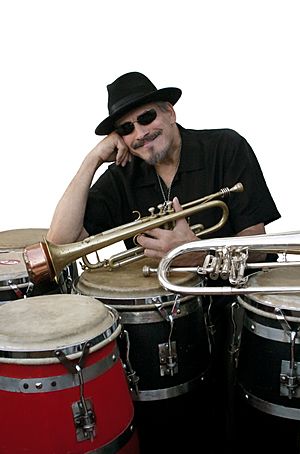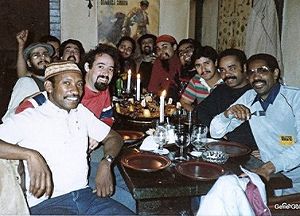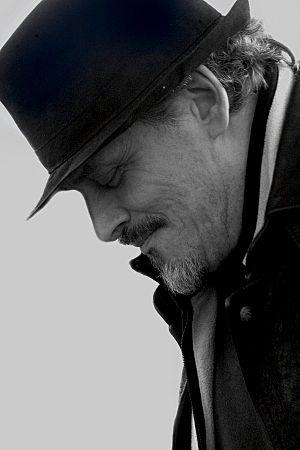Jerry González facts for kids
Quick facts for kids
Jerry González
|
|
|---|---|
 |
|
| Background information | |
| Birth name | Gerald González |
| Born | June 5, 1949 Manhattan, New York, U.S. |
| Origin | The Bronx, New York, U.S. |
| Died | October 1, 2018 (aged 69) Madrid, Spain |
| Genres | Afro-Puerto Rican Jazz, Afro-Cuban jazz, Latin Jazz |
| Occupation(s) | Musician, composer, arranger |
| Instruments | Trumpet, flugelhorn, congas |
| Associated acts | Conjunto Folklórico y Experimental Nuevayorkino, Eddie Palmieri, Manny Oquendo, Batacumbele, The Fort Apache Band, Los Piratas del Flamenco, El Comando de la Clave |
Jerry González (born June 5, 1949 – died October 1, 2018) was an American musician. He was a bandleader, trumpeter, and percussionist. Jerry had Puerto Rican family roots.
His father, Geraldo, was a singer in a band. He also worked for stores selling Latin American products. Jerry loved music from a young age. He studied the trumpet and the congas.
Jerry González and his brother, Andy González, were very important. They helped create Latin Jazz in the late 1900s. In the 1970s, they played with famous musicians like Eddie Palmieri. They also played in Manny Oquendo's Conjunto Libre.
From 1980 to 2018, they led their own band, The Fort Apache Band. After 2000, Jerry lived in Madrid, Spain. There, he led other bands like Los Piratas del Flamenco. Jerry passed away in October 2018 after a fire at his home.
Contents
Biography
Jerry González's Early Life and Musical Start
Jerry González was born in 1949 in Manhattan, New York. When he was four, his family moved to the Bronx. He grew up surrounded by music. Latin, Afro-Cuban, and jazz sounds were always around him. This helped shape his love for music.
His father, Jerry González Sr., was a singer. He performed with bands during the famous Palladium era. In middle school, Jerry started playing the trumpet and congas. He also played with local bands.
Jerry decided music was his path. He studied at the New York College of Music and New York University. His first professional job was in 1964. In 1970, he began playing congas with jazz legend Dizzy Gillespie. Gillespie encouraged Jerry to mix African rhythms with jazz. This helped him create a unique sound.
Playing with Famous Bands
The next year, Jerry joined Eddie Palmieri's band. He played with them until 1974. Then, he moved to Conjunto Libre. This band was led by timbalero Manny Oquendo and Jerry's brother, Andy González.
Jerry and Andy also started other groups. These included Conjunto Anabacoa and Grupo Folklórico y Experimental Nuevayorkino. They recorded two albums with the latter group. These albums were Concepts of Unity (1974) and Lo Dice Todo (1975).
Jerry also played with many other famous musicians. These included Tito Puente (from 1984 to 1999) and McCoy Tyner (from 1984 to 1990). He also played with Jaco Pastorius's band.
The Fort Apache Band's Success
In 1979, Jerry González released his first album as a band leader. It was called Ya yo me curé. Soon after, he formed his most famous group. This was The Fort Apache Band. His brother Andy was also a key member.
Their first two albums were recorded live at jazz festivals in Europe. These were The River is Deep (1982) and Obatalá (1988). Their hit album, Rumba Para Monk (1988), brought them wide attention. It even won the Jazz Record of the Year award in France. This album made them very popular in the jazz world.
Later, the band became a smaller group, a sextet. It included Larry Willis on piano and Andy González on bass. Steve Berrios played drums, and Carter Jefferson and Joe Ford played saxophone.
The band continued to release great albums. These included Earthdance (1990) and Moliendo Café (1991). These albums showed how well they could mix Latin sounds with jazz. After Moliendo Café, John Stubblefield joined the band.
Their albums Crossroads (1994) and Pensativo (1995) were nominated for Grammy Awards. The band won "Beyond Group of the Year" from Down Beat Magazine in 1995 and 1996.
In 1996, they released Fire Dance. This album had new versions of Thelonious Monk songs. The band won many awards for their work. In 1998, they won big at the New York Jazz Awards. In 1999, they again won "Beyond Group of The Year" from Down Beat Magazine.
In 2005, Jerry González & the Fort Apache Band honored Art Blakey and the Jazz Messengers. Their album was called Rumba Buhaina. This was their first album as a quintet.
In 2008, the Heineken Festival honored Jerry and Andy González. They were the first Puerto Ricans to receive this honor. In 2011, Arturo O'Farrill's Afro Latin Jazz Orchestra also honored them.
Jerry González's Years in Spain
Jerry's fame grew after he appeared in the film Calle 54. This movie was about Latin jazz. Many famous Latin jazz musicians were in it. Jerry also appeared in other films like Crossover Dreams and Piñero. He even appeared on Sesame Street.
After Calle 54 came out in 2000, Jerry moved to Madrid, Spain. He had only planned to visit for a day. But he ended up staying there. He became very interested in flamenco music. He started to mix jazz with flamenco.
This led to his album Los Piratas del Flamenco (2004). This band and album included flamenco artists. It had a new sound, without bass, drums, or piano. It was a fresh mix of jazz and flamenco. The album was nominated for a Grammy Award. It also won the Critics Award in New York.
Jerry also played with other flamenco stars. These included Enrique Morente and Paco de Lucía. He also played with pop musicians like Andrés Calamaro.
His later albums included A primera vista (2002) and Music for Big Band (2006). He also released Avísale a mi contrario que aquí estoy yo (2010). This album was with his Spanish quartet, El Comando de la Clave. It was nominated for a Spanish Music Award. The American version of this album was also nominated for a Latin Grammy.
In 2010, Jerry received the "Latino of the Year Award" in Madrid. He also recorded albums with Spanish bassist Javier Colina and flamenco guitarist Niño Josele. He recorded another Fort Apache album live in 2012.
Collaborations with Other Musicians
Throughout his career, Jerry González played with many great musicians. Some of these include Dizzy Gillespie, Tito Puente, and McCoy Tyner. He also performed with Paco de Lucía, George Benson, and Paquito D'Rivera.
Discography
- As a leader
- Ya Yo Me Curé (American Clavé/Sunnyside, 1979/1982)
- The River Is Deep (Enja, 1982)
- Obatalá (Enja, 1988)
- Rumba Para Monk (Sunnyside, 1988)
- Earthdance (Sunnyside, 1990)
- Moliendo Café (Sunnyside, 1991)
- Crossroads (Milestone, 1994)
- Pensativo (Milestone, 1995)
- Fire Dance (Milestone, 1996)
- Jerry González & The Fort Apache Band: Live (1996)
- Calle 54 (Calle 54, 2000)
- Jerry González & Federico Lechner: A Primera Vista (2002)
- Jerry González & Los Piratas del Flamenco (Lola Records/Sunnyside, 2004)
- Rumba Buhaina (Sunnyside, 2005)
- Music For A Big Band (Youkali/Universal, 2006)
- Avísale a Mi Contrario que Aquí Estoy Yo (Cigala Music/Warner, 2010)
- Jerry González y El Comando de La Clavé (Sunnyside, 2011)
- Jerry González & Miguel Blanco Big Band: A Tribute to the Fort Apache Band (Youkali, 2014)
- As sideman
- George Benson: The Other Side of Abbey Road (A&M/CTI, 1969)
- Dizzy Gillespie: Portrait of Jenny (Perception, 1970)
- Eddie Palmieri: Sentido (1973)
- Grupo Folklórico y Experimental Nuevayorkino: Concepts of Unity (Salsoul, 1975)
- Grupo Folklórico y Experimental Nuevayorkino: Lo Dice Todo (Salsoul, 1976)
- Paquito D'Rivera: Blowin' (Columbia, 1981)
- McCoy Tyner: Looking Out (Columbia, 1982)
- Tito Puente: On Broadway (Concord Picante, 1982)
- Abbey Lincoln: Talking To The Sun (Enja, 1983)
- Jaco Pastorius: Live In New York, Vol. I & III (Big World, 1985)
- Soundtrack of the motion picture: Crossover Dreams (Elektra, 1986)
- Paco de Lucía: Cositas Buenas (2004)
- Diego "El Cigala": Picasso en Mis Ojos (2005)
Filmography
- Crossover Dream (Leon Ichaso, 1985)
- Calle 54 (Fernando Trueba, 2000)
- Piñero (Leon Ichaso, 2001)
See also
 In Spanish: Jerry González para niños
In Spanish: Jerry González para niños





